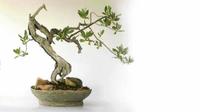Marie Elizabeth Casserly, Contributor
At David Pinto's pottery studio, nestled in the hills of Trelawny overlooking the snaking Martha Brae, an eager group assembled to start an exciting adventure a journey into the ancient art of bonsai!
Certainly, Good Hope?s sprawling centuries-old guango and mango trees and its majestic whispering bamboos presented an idyllic backdrop for an inspired exploration into the dramatically contrasting world of miniature. Conceived by David Pinto, well-known Jamaican ceramic artist, who made Good Hope his home close to 15 years ago and who has since then, along with the creation of clay pots and sculpture, been immersed in the avid planting of trees, the journey into bonsai emerged as the shining bridge to indulge his passions for the earth, clay and green.
Pinto called on two outstanding bonsai enthusiasts to collaborate with him on the workshop, by sharing their love and knowledge of bonsai through discussion, demonstration and hands-on experience ?Michael 'Woody' Woods and Kynan Cooke.
Woods, a photographer by trade who boasts an extensive collection of trees, some as old as 50 years, started bonsai in 1995, with no training, and is now an accomplished bonsai grower, having won multiple first-place prizes at the Jamaica Horticultural Society's (JHS) annual shows.
Cooke, whose entry was awarded "Best of Show" for Bonsai in the 2006 JHS show, became interested in the art three years ago when he bought his first starter tree. A year later he began his own collection and now has over 100 trees in training. With the caring attention of David, Kynan and Woody, the participants all created outstanding starter trees carefully positioned in a Pinto original pot to take home and nurture, and had the added pleasure of being introduced by David to hand-building their own clay bonsai pots! Most participants worked with miniature or dwarf ixora (Ixora coccinea cultivar) but watched demonstrations involving ebony and other trees.
What is bonsai
So, what is 'bonsai' Literally translated from Japanese, the term 'bonsai' means 'tree in tray' (or pot). In Western culture, the word 'bonsai' is most often used as an umbrella term for the Japanese 'bonsai', Chinese 'penjing' and Korean 'bunjae'. The art form originated in China more than 2,000 years ago, beginning with the collection of naturally dwarfed trees which had grown under adverse conditions, such as in shallow pockets of soil on rocky cliff faces where they had struggled for survival while being battered by the elements. Over time these trees took on a beautiful, majestic appearance that became highly sought after by collectors. After its spread to Japan, and in response to the increasing demand for the trees, the practice and art of bonsai was further refined to include the cultivation and training of trees in special nurseries. The introduction of bonsai to the western world is believed to have occurred in the mid-nineteenth century and its popularity intensified thereafter, in particular, following the World Exhibition in Paris in 1900.
Bonsai are ordinary trees or plants, not special hybrid dwarfs. Small-leafed varieties are most suitable, but essentially any plant can be used, regardless of the size it grows to in the wild. In Japan, varieties of maple, pine, azalea, camellia, bamboo and plum are most often used. The bonsai artist never duplicates nature but rather expresses a personal aesthetic philosophy by manipulating it. The bonsai may suggest many things, but in all cases must look natural and never show the intervention of human hands. Bonsai have the same requirements as any other plant to grow ? light, water and food ? but prescribed methods are followed to control the growth of the tree in order to achieve the desired results.
Styles
There are six basic styles of bonsai: Formal Upright; Informal Upright; Slanting; Cascade; Semi-Cascade and Group (Twin Trunks; Multiple Trunks; Clump; Raft; Multiple Trees ? with the exception of Twin Trunks, all group plantings are odd numbers of trunks or trees). Bonsai vary in size, ranging from no more than one inch to four feet and over, and can be grown in any type of soil, so long as the correct mix of two or three important ingredients is maintained. Free drainage of excess water is essential, therefore, the soil is composed mostly of grit, along with humus and loam, and pots have generous drainage holes and unglazed interiors. It should be noted that the bonsai pot is not merely a container for the tree, but should complement the tree, resulting in an aesthetically pleasing composition.
Other points to bear in mind in the selection of the pot are visual balance with respect to depth and width of the pot in relation to the tree, and the point at which the tree is placed in the pot. Trees should ideally be planted off-centre, as in the tradition it is believed that the centre is where both 'heaven and earth meet', therefore, this point should not be obstructed.

